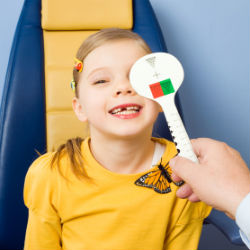Detecting visual impairments

by Richard Haber, MD
Recently, I saw an 8-year-old girl for the first time for a well-child examination. She had no specific complaints, but assessment of her vision using a Snellen chart revealed the following: OD 20/20, OS 20/200. Further evaluation showed a slight strabismus of the left eye that hadn’t been detected earlier and was responsible for her amblyopia. This is a tragedy and indicates the importance of assessment of the visual system in all infants and children. An early referral to an ophthalmologist would have resulted in saving the vision in that eye.
An eye on the exam
An eye on the exam
The Canadian Paediatric Society, the AmericanAcademy of Pediatrics and the U.S. Preventive Services Task Force all recommend assessment of the visual system at every well-child visit, starting in the newborn period. Between infancy and age 3 years, it’s important to inspect the external structures of the eyes — including lids, conjunctiva, cornea, iris and pupils — as well as assessing function of the eye itself. I refer the reader to the articles below for a detailed discussion of this examination and will limit myself to three “pearls.”
First, in young infants, obtain the red reflex. This simple test can detect corneal abnormalities, such as clouding and cataracts, as well as retinoblastoma and other retinal anomalies. In a darkened room using an ophthalmoscope, examine each eye separately from a distance of about 30-45 cm, and then both eyes together at 1 metre away. The red reflex is analogous to cats’ eyes that light up at night in your headlights. The colour is usually a bright reddish-yellow, or light grey in darkly pigmented individuals. A dark spot, a dull red or a white reflex requires referral.
The Hirschberg corneal reflex test picks up strabismus, the commonest cause of amblyopia if undetected. Shine a light onto the baby’s face from a distance of about 45-60 cm and check where it falls. In normally aligned eyes, the reflection should be ‘twinned’ and centred in both pupils. A slight nasal displacement is normal. If the light reflected from both corneas is not ‘twinned’, then the eyes are crossed.
The third aspect is visual acuity — does the child see from this eye? Even an infant should be able to fixate and follow an appropriate target. A baby with poor visual acuity from one eye will cry or resist having the good eye covered. Promptly refer if you have any suspicions. Children 3 years and older should have their visual acuity checked annually until the age of 5, and then every 2 years until age 18.
Interpreting the chart
Interpreting the chart
A Snellen letters chart or a picture chart for young children will assess distance vision. The line read with ≥ 4 correct answers out of 6 is the visual acuity. If the child’s vision is less than 10/15 or greater than 20/30, or if there’s a 2-line difference between the eyes, a referral is warranted.
Stats
Stats
- 5-10% of all preschoolers have a visual impairment
- Infants may normally cross their eyes until 2-3 months of age
- At 3-6 months, this is abnormal — refer to an ophthalmologist
- Half the children with strabismus may develop amblyopia
- Lazy eye — prevalence of 1-5% — is the leading cause of unilateral vision loss in adulthood
References:
References:
Community Paediatrics Committee. Paediatrics & Child Health 1998;3(4):261-2.
AAP Policy. Pediatrics 2003;111(4 Pt 1):902-7.
U.S. Preventive Services Task Force. Am Fam Physician 2005;71(2):333-6.
AmericanAcademy of Pediatrics. Pediatrics 2002;109(5):980-1.
Richard Haber, MD, FAAP, FRCPC is an associate professor of pediatrics at McGill University and the Director of the Pediatric Consultation Centre at the Montreal Children’s Hospital.


